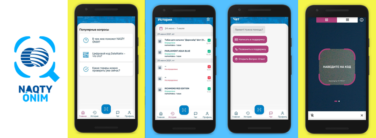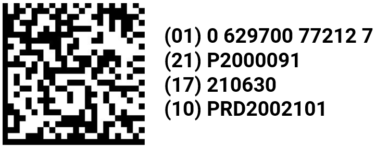Welcome to Part 2 of our series about Kazakhstan serialization and traceability requirements. Part 1 detailed the country context, including government efforts to achieve pharma independence. October 1, 2022, is the next deadline in the rollout of Kazakhstan pharma serialization, so today we’ll get into the specifics of the regulations, as well as regulations for other key industries. Let’s get started.
Kazakhstan pharma serialization: pilot, goals, operator, timeline, marking requirements
The transformation of Kazakhstan’s pharmaceutical supply chain began almost seven years ago, when the government in September 2015 issued guidelines on labeling, marking, and requirements for accessing and uploading data to a central portal. In November of the same year, the Ministry of Health tapped GS1 Kazakhstan to conduct a pilot for the traceability system, which is called the Special Information System for Marking and Traceability of Goods (IS MPT).
Pilot
The pilot ran from Sept. 9, 2019, to July 31, 2021. It was led by Kazakhstan’s state-run distributor, SK Pharmacy, which labeled 100,000 packages of 30 different drugs and traced them all the way through the supply chain to hospitals and pharmacies. Four domestic manufacturers, 1 importer, 2 distributors, 5 pharmacies, and 8 medical institutions also participated.
Goals
The goals of Kazakhstan pharma serialization — and labeling of other product categories — are essentially the same as regulatory goals in other countries:
-
-
- Communicating product information to consumers
- Combating counterfeit and falsified products
- Eliminating gray markets (“Shadow market” seems to be the preferred term in Kazakhstan.)
- Protecting consumers
- Protecting legal businesses
- Identifying entities that violate tax laws
-
The Kazakh government has also said that digital labeling will help businesses increase productivity, improve logistics, increase market share, ultimately leading to increased revenue.
IS MPT Operator
Kazakhtelecom JSC, the country’s largest telecommunications company, operates the IS MPT. Sometimes referred to as “the Single Operator,” it’s the equivalent of Russia’s Center for Research in Perspective Technologies (CRPT) and Uzbekistan’s CRPT Turon. Its main offices are in Nur-Sultan (formally Astana) and Almaty.
As operator, Kazakhtelecom JSC is responsible for the following:
-
-
- Generating marking codes
- Providing traceability to the state
- Interacting with the integrated system of the Eurasian Economic Commission (EEC) and operators in other Eurasian Economic Union (EAEU) states
- Providing a digital passport of goods for market participants
- Developing a free mobile application (NAQTY SAUDA) to accept and withdraw marked goods from circulation (primarily for participants who are unable to purchase scanners)
- Developing a free mobile application (NAQTY ÓNIM) for the public to participate in the system
- Creating a 24/7 IS MPT contact center
-
In official government reporting dated Nov. 17, 2020, Kazakhtelecom JSC’s Chair of the Board Kuanyshbek Yessekeyev talked about the benefits of the IS MT. “Among its main advantages,” he said, “one can single out a decrease in the shadow market by 50 percent until 2025, which will lead to additional budget revenues by 2025 in the amount of 58.4 billion tenge [$122.5 million], according to our calculations.”
Yessekeyev also concluded that additional legal business revenues would reach 336.5 billion tenge [$706.5 million] by 2025.
Timeline
Here are the key dates for Kazakhstan pharma serialization:
Planning and pilot
-
-
- September 2015: The government issues guidelines on labeling, marking, and requirements for accessing and uploading data to a central portal.
- November 2015: The Ministry of Health taps GS1 Kazakhstan to conduct a pilot for IS MT.
- 2018–2019: GS1 Kazakhstan conducts testing for the pilot.
- Sept. 9, 2019: The pilot begins.
- July 31, 2021: The pilot ends and the government issues serialization guidelines.
- August 8, 2021: The Ministry of Health identifies 93 products — about 1% of all drugs in the country — for the first phase of serialization.
-
Rollout (note upcoming deadlines in October and early 2023)
-
-
- June 5, 2022: The Ministry of Health delays the first phase of serialization from May 2022 until August 1, 2022.
- August 2022: Mandatory serialization for the 93 products begins. This list includes drugs produced by four Kazakh manufacturers and 12 foreign manufacturers.
- October 1, 2022: Mandatory serialization for 20% of drugs scheduled to begin.
- January 1, 2023: Mandatory serialization for 60% of drugs and mandatory data reporting for 20% of drugs scheduled to begin.
- April 1, 2023: Mandatory serialization of at least 80% of drugs scheduled to begin.
- July 1, 2023: Mandatory serialization of 100% of drugs scheduled to begin
-
Note: At present, Kazakhstan pharma serialization regulations do not require aggregation.
Marking requirements
As in other EAEU and Commonwealth of Independent States (CIS) countries (e.g., Russia and Uzbekistan, respectively), products must be labeled with a DataMatrix code with four data points:
-
-
- A 14-digit product code (i.e., Global Trade Item Number, or GTIN) (GS1 Application Identifier 01)
- A 13-character randomized serial number (21)
- A four-character verification key (91)
- A 44-character verification code (92)
-
The maximum cost of one code will be 2.68 tenge ($0.0056) without VAT. Every code goes through the same five steps during its “lifetime”:
-
-
- The manufacturer applies a code to every package and sends them to a distributor.
- The distributor receives and scans the products, then sends them to the retailer (e.g., a store or supermarket).
- The retailer receives the new (legal) batch of goods, scans the codes, and sells the products.
- At checkout, the cashier scans each code (either with a scanner or using the NAQTY SAUDA app) and it’s withdrawn from circulation.
- Consumers can use the NAQTY ÓNIM app to learn more about the product.
-
Here are some images of the apps:

Other regulated products/industries
In 2019, Kazakhstan ratified an agreement for labeling of goods within the territory of the EAEU. In doing so, it agreed to the EEC’s decisions concerning labeling of fur products, shoes, perfumes, tires, and other products. Here is the latest information from IS MPT:
-
-
- Tobacco products: Mandatory labeling of cigarettes began Oct. 1, 2020; April 1, 2021, for cigars, cigarillos, and other categories.
- Fur products: Mandatory labeling began March 1, 2019.
- Footwear: Production and import of unmarked shoes have been prohibited since Nov. 1, 2021; sale of unmarked shoes has been prohibited since April 1, 2022.
- Alcohol: Mandatory labeling began April 1, 2021.
- Light industry (primarily clothing and linens): A pilot ran from Dec. 15, 2020, to Dec. 31, 2021.
- Dairy products: A pilot began on Oct. 1, 2020, and was extended in November 2021.
- Soft drinks: A pilot ran from July 1, 2020, to Jan. 31, 2022
- Jewelry: A pilot began in March 2022 and is scheduled to end on Oct. 31, 2022.
-
Final thoughts
That’s a lot to think about. We’ve provided the granular details of Kazakhstan pharma serialization requirements, but let’s boil them down to what you have to be ready for in just a few weeks: Mandatory serialization for 20 percent of drugs starts on October 1.
If this affects you, are you ready? The good news is that complying with Kazakhstan pharma serialization requirements doesn’t have to be difficult. The fastest way to ensure you’re ready for the October deadline — and all the 2023 deadlines — is to contact us and walk through our solutions with one of our supply chain experts.
We offer a holistic, fully validated, preconfigured, automated platform for compliance and L1-L5 connectivity. With rfxcel and Antares Vision Group, you’ll be prepared for regulations in the EAEU and everywhere else your supply chain goes.




